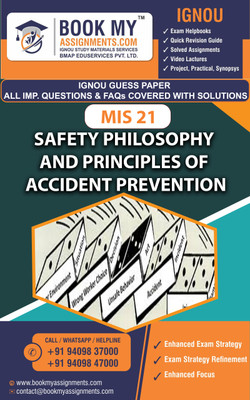IGNOU MIS 021 Safety Philosophy and Principles of Accident Prevention | Guess Paper | Important Question Answer | Master of Arts (Environmental and Occupational Health) (MAEOH)(Paperback, BMA Publication)
Quick Overview
Product Price Comparison
Introduction to Safety Philosophy:Define safety philosophy and its significance in various industries and workplaces.Discuss the evolution of safety management systems and the importance of a proactive approach to safety.Basic Concepts of Safety:Define key terms and concepts related to safety, such as hazard, risk, safety culture, safety climate, and accident/incident.Discuss the differences between safety and security, safety and health, and safety and environmental protection.Safety Management Systems (SMS):Introduce safety management systems (SMS) and their components, such as policy, planning, implementation, evaluation, and improvement.Discuss the role of management commitment, leadership, and employee involvement in establishing and maintaining an effective SMS.Safety Standards and Regulations:Explain the importance of safety standards, regulations, and legal requirements in ensuring workplace safety.Discuss relevant national and international safety standards and regulatory agencies.Safety Culture and Climate:Define safety culture and safety climate and their influence on safety performance.Discuss strategies for promoting a positive safety culture, including communication, training, leadership, and organizational support.Hazard Identification and Risk Assessment:Explain the process of hazard identification and risk assessment in identifying and prioritizing workplace hazards.Discuss methods for assessing and evaluating risks, such as risk matrices, risk assessment matrices, and risk registers.Accident Causation Theories:Introduce various accident causation theories, such as Heinrich's Domino Theory, Bird's Model, and Reason's Swiss Cheese Model.Discuss the importance of understanding the root causes of accidents for preventing future incidents.Accident Investigation and Analysis:Describe the steps involved in accident investigation and analysis, including data collection, root cause analysis, and corrective action planning.Discuss techniques for conducting effective accident investigations, such as fault tree analysis, event tree analysis, and fishbone diagrams.Human Factors in Safety:Discuss the role of human factors in safety, including human error, behavior-based safety, and human performance.Explore strategies for addressing human factors issues in safety management, such as training, procedural changes, and ergonomic design.Safety Leadership and Communication:Discuss the importance of safety leadership and effective communication in promoting a safe work environment.Explore leadership styles, communication strategies, and techniques for engaging employees in safety initiatives.

